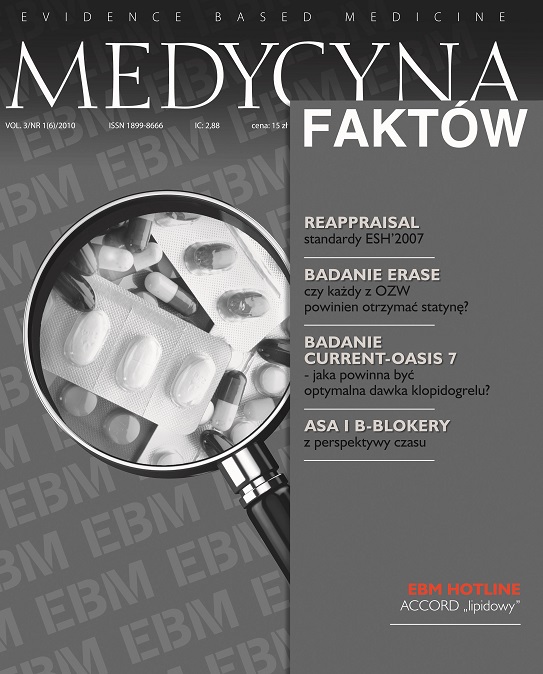Meaning of statin use in vascular surgery Review article
Main Article Content
Abstract
The use of statins is widespread and many patients presenting for surgery are regularly taking them. There are clinical evidences that statins have beneficial effects, including reducing the perioperative risk of complications. This review addresses the pleiotropic effects of statins. Especially advantageous influence has been observed of numbers of patients presenting for cardiac or vascular surgery. The clinical evidence shows that statin use in the perioperative period reduces numbers of cardiac events after open aortic aneurysm repair, peripheral revascularizations or carotid endarterectomy. There is evidence that statins have beneficial anti- inflammatory actions beyond their lipid lowering effects. Statins decrease risk of sepsis.
Article Details
Copyright © by Medical Education. All rights reserved.
References
2. Grabowski M., Filipiak K.J.: Simwastatyna – czy ma przewagę nad innymi statynami? Choroby Serca i Naczyń 2008; 3(supl. A): A1-A4.
3. Cieślak-Stanik D., Broncel M.: Statyny – działanie przeciwzapalne. Problemy Terapii Monitorowanej 2004; 15: 36-53.
4. Ridker P.M., Rafii N., Pfeffer M.A. et al.: Long-term Effects of Pravastatin on Plasma Concentration of C-reactive Protein. Circulation 1999; 100: 230-235.
5. Albert M.A., Danielson E., Raifai N. et al.: Effect of statin therapy on C-reactive Protein Levels. The pravastatin inflammation/CRP evaluation (PRINCE): A randomized trial and cohort study. JAMA 2001; 286: 64-70.
6. Owns J.R., Clearfild M., Tyroler H.A. et al.: AFCAPS/TEXCAPS: additional perspectives on tolerability of long-term treatment with lovastatin. Am. J. Cardiol. 2001; 87: 1074-1079.
7. Fleischer L.E., Beckman J.A., Brown K.A. et al.: ACC/AHA 2007 guidelines on perioperative cardiovascular evaluation and care for noncardiac surgery. Circulation 2007; 116: 418-500.
8. Perler B.A.: The effect of statin medications on perioperative and long-term outcomes following carotid endarterectomy or stenting. Semin. Vasc. Surg. 2007 Dec.; 20(4): 252-258.
9. Almog Y., Shefer A., Novac V. et al.: Prior statin therapy is associated with a decreased rate of severe sepsis. Circulation 2004; 110: 880-885.
10. Brookes Z.L.S., McGrown C.C., Reilly C.S.: Statins for all: the new premed? British Journal of Anaesthesia 2009; 103(1): 99-107.
11. Hacman D.G., Mamdani M., Li P., Redelmeier D.A.: Statins and sepsis in patients with cardiovascular disease: a population-based cohort analysis. Lancet 2006; 367: 413-418.
12. Maron D.J., Fazio S., Linton M.F.: Current perspectives on statins. Circulation 2000; 101: 207-213.
13. Laufs U., La Fata V., Plutzky J. et al.: Upregulation of endothelial nitric oxide syntheses by HMG-CoA reductase inhibitors. Circulation 1989; 97: 1129-1135.
14. Ross R.: Atherosclerosis: an inflammatory disease. N. Engl. J. Med. 1999; 340: 115-126.
15. Bolewski A., Plewo R., Siminiak T.: Udział czynników zapalnych w patogenezie miażdżycy. Polski Przegląd Kardiologiczny 2003; 5(1): 61-69.
16. Chojnowska-Jezierska J.: Pozalipidowe działania statyn – nowy kierunek prewencji i terapii antymiażdżycowej. Problemy Terapii Monitorowanej 2000; 11: 61-69.
17. Goldstein L.B., Amarenco P., Szarek M. et al.: Hemorrhagic stroke in the Stroke Prevention by Aggressive Reduction in Cholesterol Levels study. Neurology 2008; 70: 2364-70.
18. Scalia R., Gooszen M.E., Jones S.P. et al.: Simvastatin exerts both anti-inflammatory and cardioprotective effects in apolipoprotein E-deficient mice. Circulation 2001; 103: 2598- 2603.
19. Schwartz G.G., Olsson A.G., Ezekowitz M.D. et al.: Effects of atorvastatin on early recurrent ischeamic events in acute coronary syndromes: the MIRACL study: a randomized controlled trial. JAMA 2001; 285: 1711-1718.
20. Uzui H., Lee J.D., Shimizu H. et al.: The effect of pravastatin on the production of matrix metalloproteinase in vascular smooth cells. JACC 2001; 37: P1131-P1191.
21. Bronce M., Cieślak-Stanik D., Chojnowska-Jezierska J., Koter M.: Działanie przeciwzapalne i antyoksydacyjne simwastatyny u pacjentów z hiperlipidemią typu II. Problemy Terapii Monitorowanej 2003; 14: 176-185.
22. Sandset P., Lund H., Norseth J.: Treatment with hydroxyglutaryl-CoenzymA reductase inhibitors in hypercholesterolemia changes in the components of the extrinsic coagulation system. Arteriol. Thromb. 1991; 11: 138-145.
23. Colli S., Eligini S., Li M. et al.: Vastatins inhibit tissue factor in cultured human macrofages. Atherosc. Tromb. Vasc. Biol. 1997; 17: 265-272.
24. Rosenson R., Lowe G.: Effects of lipids and lipoproteins on thrombosis and rheology. Atherosclerosis 1998; 140: 271-280.
25. Chojnowska-Jezierska J.: Atorwastatyna – lek o najsilniejszym działaniu hipolipemicznym. Problemy Terapii Monitorowanej 2000; 11: 160-174.
26. McGirt M., Perler B., Brooke B. et al.: 3-Hydroxy-3-metylglutaryl coenzyme A reductase inhibitors reduce the risk of perioperative stroke and mortality after carotid endarterectomy. J. Vasc. Surg. 2005; 42: 829-836.
27. Amarenco P., Labreuche J., Lavallee P. et al.: Statins in stroke prevention and carotid atherosclerosis: systematic review and metaanalysis. Stroke 2004; 35: 2902-2909.
28. Martin-Ventura J.L., Blanco-Colio L.M., Gomez-Hernandez A. et al.: Intensive treatment with atorvastatin reduces inflammation in mononuclear cells and human atherosclerotic lesion in one month. Stroke 2005; 36: 1796-1800.
29. Amarenco P.: Atorvastatin in prevention of stroke and transient ischemic attack. Expert Opin. Pharmacother. 2007; 8: 2789-2797.

